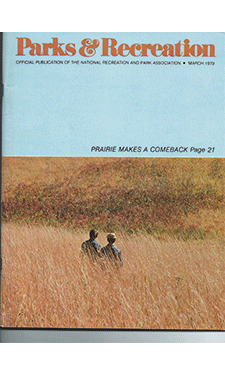 This month, NRPA Vice President of Conservation and Parks Richard Dolesh tackles the subject of our dwindling pollinators and what must be done to shore up their populations. Springtime some 36 years ago, authors Donna Kostka and Ron Bowen, in their Parks & Recreation feature article, “Prairie Makes a Comeback,” were focused on prairie restoration, although with different goals in mind.
This month, NRPA Vice President of Conservation and Parks Richard Dolesh tackles the subject of our dwindling pollinators and what must be done to shore up their populations. Springtime some 36 years ago, authors Donna Kostka and Ron Bowen, in their Parks & Recreation feature article, “Prairie Makes a Comeback,” were focused on prairie restoration, although with different goals in mind.
“Faced with conflicting demands for tight budgets and improved esthetics, alternatives are being sought to provide additional natural beauty, interpretive value, animal habitat and economy,” they write. “Because manicured lawns and traditional landscaping limits these things, more and more park departments are restoring some of their space to native habitats. Prairie, with its diverse community of native grasses and flowers, is especially well-suited for this ‘new’ kind of landscaping.” Kostka and Bowen go on to provide a how-to guide for agencies looking to jump on the prairie restoration bandwagon, suggesting seed collection methods, land preparation and maintenance strategies.
Although they don’t couch these efforts in conservation terminology, their suggestion of low-maintenance native plantings certainly tracks with the concept and, to Dolesh’s presumed delight, would provide habitat and food for pollinating insects. Kostka and Bowen may not have had pollinators on the brain when penning their practical prairie guide, but their maintenance- and budget-friendly suggestion of including such areas within our public parklands could prove an effective strategy for mitigating the loss of pollinator species.
Stinky Sneakers and Community Engagement
Professionals in our field are always looking for innovative ways to bring more people into their recreation centers and parks — the 1976 iteration of the Montpelier, Vermont Recreation Department (MRD) stumbled upon an intriguing method to do just that, and shared it with readers of the March 1979 issue. Author Terrence Costin, then-director of recreation at MRD, described the origins of the “Rotten Sneaker Contest” thusly: “The contest started when a local sporting goods store wanted to run a picture with a beaten up, old pair of sneakers and a new, clean pair of sneakers in an advertisement. They approached our department with the question — ‘Are there any old sneakers kicking around the recreation center?’ We invited them over with a camera, and a quick survey of the sneakers present revealed at least five pair that were eligible for the advertisement. We examined shoes from the sidelines and selected four finalists. From these we selected a winner. The group’s picture appeared on the front page of the local papers, and we received incredible response. In fact, the response was so good, we decided to make the contest an annual event.”
The contest is held to this day — it’s now a nationwide event dubbed the “Odor-Eaters Rotten Sneaker Contest,” after the insole manufacturing company became the contest’s official sponsor in 1988. When it was still MRD’s baby, the contest was open to anyone in the town and judging was based on six categories: tongue, sole, eyelets, heel, toe and smell (gross). Today, it’s open to children ages 5-15 with judging based on the less-specific categories of odor (still gross), condition and the child’s verbal account of why and how his or her sneakers are the stinkiest.
While its purpose has changed, back in 1979 MRD’s Rotten Sneaker Contest provided a good example of how, with the right mindset, an innocent search for a nasty pair of shoes can become a fantastic public relations event. “From a program perspective, the contest has been a tremendous success,” Costin writes. “Virtually no cost is involved. We attract all ages and all styles. And it is a fantastic promotional tool that has resulted in extensive local and national publicity.”
We should all be so clever — preferably without having to stick our noses in a stranger’s stinky shoes.
Samantha Bartram is the Associate Editor of Parks & Recreation magazine.

